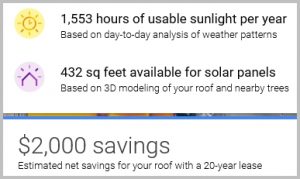For many years I mulled over the idea of getting solar panels for my home in Petworth after checking out homes on the Solar Home Tour. I was inspired by these homeowners who I consider to be solar pioneers. By the way, mark your calendars, the 2017 tour will take place October 7 & 8.
I was also inspired by Anya Schoolman who founded the Mt. Pleasant Solar Coop in 2007 and is now the Executive Director of the Community Power Network. She has been a great advocate for solar in DC. Check out the DC SUN (DC Solar United Neighborhoods) website and join the DC SUN newsletter and listserv. DC SUN recently launched two new solar co-ops in Manor Park and Georgetown-Burleith neighborhoods. “Co-op members can save up to 20% off the cost of going solar and will have the support of fellow co-op members as well as DC SUN throughout the process,” according to the DC SUN website. Anne Thiel, Manor Park Resident, is considering joining the co-op. She said that she is interested in learning more about the overall costs and cost benefits involved in getting solar panels. One thing she is not sure about is the condition of her roof, which may need to be replaced before getting solar. Learn more about joining the co-ops.
Special thanks to Sam Polino, Director for Solar Co-ops at Community Power Networks for sharing these resource links.
o New Solar Co-ops in Manor Park, Georgetown-Burleith
o All About SRECs (Solar Renewable Energy Certificates)
o Community Solar Finally Happening in DC
Getting Started
I started researching different companies, and the different options for getting solar panels. Before getting panels, I had to make sure my roof was in good shape, and there was nothing shading the roof. Luckily the house is on a hill, so there are no trees shading the roof.

Pro Tip: Map Your Roof’s Solar Potential
Put your address in Google’s Project Sunroof to see how usable sunlight you have per year, and how many square feet you have on your roof for panels based on 3D modeling of your roof and nearby trees. Here’s what I got when I put in my address.
If you are considering purchasing solar panels, you can use this Solar Financial Calculator* to investigate the likely payback period and longer term financial projections under different solar purchase scenarios. *The Solar Financial Calculator, created by solar homeowner Kyle Yost, is read-only. To edit parameters specific to your situation (for example system size, cost per watt, etc….), choose File->Make A Copy to create your own editable version.

Pro Tips: Why Go Solar Now?
 “The confluence of incentive packages and lower panel prices make it an ideal time to go solar,” explained Robert Valette, Project Manager at Solar Solution LLC.
“The confluence of incentive packages and lower panel prices make it an ideal time to go solar,” explained Robert Valette, Project Manager at Solar Solution LLC.
From now till March 31, Solar Solution LLC is offering special rates on both lease and purchase options. Click here to sign up or learn more.
1. SRECs are at their highest evaluation.
This means you can earn more from your system to pay off your costs. Learn more about Solar Finance 101 and SRECs.
2. Net metering helps you to earn more from your system.
If your system produces more then you get full retail credit for the excess energy produced. In other cities, you get a wholesale rate credit.
3. Take advantage of the 30% federal tax credit.
Learn more about the tax credit.
4. Pepco rate hike request could result in higher electricity prices.
Learn more about the requested 5.25% rate increase.

Pro Tips: Keith Winston, Green Building Code Inspector, Permitting & Inspections, Dept. of Consumer & Regulatory Affairs (DCRA)
1. Top Tips for DC Residents Considering Getting Solar
o Learn as much as you can.
o Join the DC SUN list.
o Talk to several contractors.
o Know the basics of SRECs & tax benefits.
o Don’t be unrealistic about electrical generation, most residential systems only offset a part of your bill.
2. What to Consider When Selecting a Solar Installer
o Like any contractor, try to get references –ideally, from people you know, or at least in your area.
o Confirming that their license is in good order can be helpful.
o It’s important to realize that there are many variations in solar installations. On any given site, they might be put up flat or sloped (sloped is typically better both in terms of solar gain and self-cleaning/rainwashing), they might be string inverters (with or without optimizers) or micro-inverters (the prior can be cheaper, and put all your active electronics in one place, but optimizers or microinverters add value in handling shading/variable illumination of panels, and module-level performance tracking (typically string inverters only track by string or array).
Best Ways to Attach Solar Panels to Roof
In most cases, a parapet-to-parapet beam approach is simpler and more repeatable on row homes, than trying to figure out the condition & capacity of an 80-100 year old structure. Sloped roofs, however, have considerably greater leeway, because the slick surface and associated increased snow shedding helps offset any added weight of the solar system itself.
Variations on Solar Panels
Most panels are fairly similar (i.e. mono- vs. polysilicon), but there are interesting variations (thin-film, AC modules, parallel-architecture modules)… in each case a fully compatible/matched system is critical. Sometimes the operating parameters of one system choice will circumscribe others. I suppose the real take-away is that panel manufacture has continued to improve (even as prices have dropped). Although modules are typically warranted to 25 years, I suspect most will be productively in use long after that (how old is YOUR refrigerator?). Often there are price & performance trade-offs, but it’s also a quickly changing market. Most installers are familiar with one or a few product lines, and it is not always the best choice to push them out of their comfort zones.

Pro Tips: Kyle Yost, Georgetown Resident
Our house was net negative in its first year with solar. This earns our PV system produced more electricity than we consumed, and that includes charging our electric car. It is a powerful feeling to know that all of the energy our household requires, including car transportation, is powered by the sun and not carbon based fuels. We saved about $850 on electric bills in year 1 and received about $4000 in SREC cash payments, which puts us on track to have paid back our upfront capital costs in about 3 years and 4 months. After this time we can expect many years of profit.
The value of our home has surely increased due to the power station on the roof. If we were to move, we would maintain the rights to the SRECs produced by the home, but the new owner would benefit from the electricity the roof was providing and the resultant bill savings.
Understand the quality of your roof for solar. South and west facing roofs are good. North and east will not produce enough to be worthwhile. Most importantly, shade kills, even more than you would think. In a normal single string system, a bit of shade on a single panel negatively impacts the entire system, including panels not in the shade. This means that a chimney or satellite dish or something that may seem innocuous and minor can actually have major impact. Better than the standard “string” system are microinverters or power optimizers, which mitigate much of this and cause each panel to operate independently. While cheaper, do not get a string inverter system unless you have a virtually perfect roof, as any little bit of shade kills.”
Questions?
You can email Roshani at
roshani[at]greenddcliving.com..
Share Your Questions & Tips
Feel free to post your questions and comments below.



SRECS are NOT all at their highest valuation. While the DC market for SRECS has been strong and steady for several years, Maryland market prices for SRECS have fallen from well over $100 to well under $100 under a new administration less friendly to solar, and in Virginia there is no SREC market.